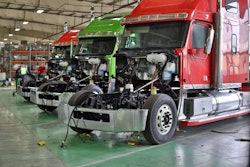CCJ‘s Indicators rounds up the latest reports on trucking business indicators on rates, freight, equipment, the economy and more.
The for-hire trucking industry in July added another 2,000 workers to its payroll, according to the Department of Labor’s monthly Employment Situation Summary. July’s employment gains were a continuation of the industry’s now years-long jobs rally, dating back to early 2017. Since February of 2017, the for-hire trucking industry has added more than 75,000 jobs, according to DOL statistics.
The U.S. economy as a whole in July added 164,000 jobs, and the country’s unemployment rate was 3.7 percent.
Employment in the trucking industry totaled 1.524 million in the month — a gain of more than 36,000 jobs from the same month last year.
The transportation and warehousing sector — the umbrella sector for trucking — added just 300 jobs in the month. Major freight-producing sectors manufacturing and construction added 16,000 jobs and 4,000 jobs, respectively.
FTR: Freight environment weak but growing
Freight research group FTR this week issued a brief reporting noting that freight demand is weaker than the general economy. Though GDP growth in the second quarter was 2.1 percent, the components of GDP linked to goods transportation was much weaker — just 0.5 percent on an annualized basis, says FTR.
The goods transportation sector grew at 3.2 percent in 2018 and 5.7 percent in 2017.
“It’s a slow growth environment now, but it feels worse than that because the freight markets were so extraordinarily hot in 2018,” said Eric Starks, FTR’s chairman and CEO. “However, while freight volumes are holding up as of now, most of the risks seem to be on the downside, especially with tariffs and the overall trade climate.”
Likewise, says Starks, construction is weak and the manufacturing sector is showing “mixed signals.”
Consumer spending is holding strong, said Starks, but weather events, such as flooding in the Midwest, likely harmed grain volumes.
“After a couple of years of constant pressure on the transportation system we’re just in a more volatile and dynamic environment that requires shippers, carriers and intermediaries to be especially vigilant.”










